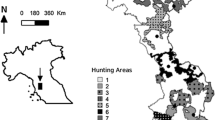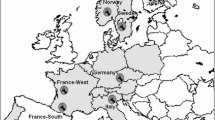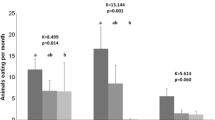Abstract
To describe the yearling antler cycle of pampas deer bucks (Ozotoceros bezoarticus) 22 bucks and 72 antler cycles have been studied in a semi-captive population. Date of individual antler cast, first day on which the brow and the trez tine were observed, and day of the velvet shedding were registered. Time intervals (days) between first and second antler casts, between first antler cast and the brow tine observation, between brow and trez tines observation and from first antler cast to velvet shedding were calculated. The brow and the trez tine were first observed 22.8 ± 0.6 and 45.9 ± 0.9 days after the first antler cast. Velvet shedding was observed 103.3 ± 2.1 days after the first antler cast. Both antlers casts were observed earlier in adult cycle bucks than in first antler bucks, although the interval between both casts was not different. The interval from the brow tine observation to the trez tine observation was shorter in first antler cycle bucks than in adults. As in other deer species, antler cycle was seasonal, but persistence of cycle-to-cycle antler growth well into adulthood is different from what occurs in most deer species.
Zusammenfassung
Um den jährlichen Geweihzyklus von Pampashirschen (Ozotoceros bezoarticus arerunguaensis) zu beschreiben, wurden 22 Hirsche und 72 Zyklen einer semikaptiven Population untersucht. Es wurden das Datum des individuellen Abwerfens des Geweihs, der erste Tag, an dem die Aug- und Mittelsprossen beobachtet wurden, und der Tag des Abreibens des Bastes registriert. Es wurden die Zeitintervalle (in Tagen) zwischen erstem und zweitem Abwerfen des Geweihs, vom ersten Abwerfen des Geweihs bis zur Beobachtung der Augsprosse und vom ersten Abwerfen des Geweihs bis zum Abreiben des Bastes berechnet. Aug- und Mittelsprosse wurden erstmalig 22.8±0.6 und 45.9±0.9 Tage nach dem ersten Abwerfen beobachtet. Beide Abwürfe wurden bei Männchen, die erstmalig das Geweih abwarfen, früher als bei erwachsenen Hirschen beobachtet, obwohl der Zeitraum zwischen erstem und zweitem Abwerfen des Geweihs nicht verschieden ist. Der Zeitraum zwischen dem Auftreten der Augsprosse und demjenigen der Mittelsprosse bei jungen Hirschen war kürzer als bei erwachsenen Tieren. Wie bei anderen Hirscharten ist der Geweihzyklus jahreszeitenabhängig, aber die Dauer des Geweihwuchses von einem Zyklus zum nächsten unterscheidet sich bis weit ins Erwachsenenalter von dem, was bei den meisten Cerviden bekannt ist.
Similar content being viewed by others
References
Bronson, F.H., 1988. Mammalian reproductive strategies: genes, photoperiod and latitude. Rep. Nut. Dev. 28, 335–347.
Bubenik, G., 1991. Regulatory mechanisms of the antler cycle and the selection of deer breeding stock by endocrine tests. In: Renecker, L.A., Hudson, R.J. (Eds.), Wildlife Production — Conservation and Sustainable Development. AFES Misc. Publ. 91-6. Fairbanks, AK, Uniersity of Alaska, pp. 521–529.
Chapman, D.L., 1975. Antlers — bones of contention. Mammal. Rev. 5, 121–172.
Dellafiore, C.M., Demaría, M., Maceira, N., Bucher, E., 2003. Distribution and abundance of the pampas deer in San Luis province, Argentina. J. Neotr. Mammal. 10, 41–47.
Drion, P.V., Hanzen, C., Wirth, D., Beckers, J.F., Leboeuf, B., Ropstad, E., Balligand, M., Bauvir, E., Gabriel, A., Collin, B., 2003. Physiologie de la reproduction et endocrinologie chez les cervidés: une revue. Ann. Méd. Vét. 147, 291–313.
Frädrich, H., 1981. Beobachtungen am Pampashirsch, Blastoceros bezoarticus (L., 1758). Zool. Gart. 51, 7–32.
Frädrich, H., 1987. Internationales Zuchtbuch für den Pampashirsch. Berlin, Germany, p. 34.
Garcia-Pereira, R.J., Barbanti-Duarte, J.M., Negrão, J.A., 2005. Seasonal changes in fecal testosterone concentrations and their relationship to the reproductive behavior, antler cycle and grouping patterns in free-ranging male pampas deer (Ozotoceros bezoarticus bezoarticus). Theriogenology 63, 2113–2125.
González, S., 1993. Situación poblacional del venado de campo en el Uruguay. In: Population and Habitat Viability Assessment for the Pampas Deer Ozotoceros Bezoarticus. Briefing Book, Rocha, Uruguay.
González, S., Maldonado, G., Leonard, J.A., Vilà, C., Barbanti-Duarte, J.M., Merino, M., Brum-Zorrilla, N., Wayne, R.K., 1998. Conservation genetics of the endangered pampas deer (Ozotoceros bezoarticus). Mol. Ecol. 7, 47–56.
Góss-Braga, F., 1999. Redescoberta do veado-campeiro, Ozotoceros bezoarticus, no estado do Paraná-Brasil. II Taller de Cérvidos del Uruguay, Montevideo, Uruguay.
Jackson, J.E., 1986. Antler cycle in pampas deer (Ozotoceros bezoarticus) from San Luis, Argentina. J. Mammal. 67, 175–176.
Jackson, J., Giullieti, J., 1988. The food of pampas deer Ozotoceros bezoarticus celer in relation to its conservation in relict natural grassland in Argentina. Biol. Conserv. 45, 1–10.
Jackson, J.E., Langguth, A., 1987. Ecology and status of pampas deer (Ozotoceros bezoarticus) in the Argentinian pampas and Uruguay. In: Wemmer, C. (Ed.), Biology and Management of the Cervidae. Smithsonian Institution Press, Washington, DC, USA, pp. 402–409.
Jungius, H., 1975–76. Status and distribution of threatened deer species in South America. Report to SSC/IUCN Deer Group. World Wildlife Fund Yearbook, Gland, Switzerland, pp. 203–217.
Lincoln, G.A., 1992. Biology of seasonal breeding in deer. In: Brown, R.D. (Ed.), The Biology of Deer. Springer, New York, USA, pp. 565–574.
Pautasso, A.A., Peña, M.I., Mastropaolo, J.M., Moggia, L., 2002. Distribución y conservación del venado de las pampas (Ozotoceros bezoarticus leucogaster) en el norte de Santa Fe, Argentina. J. Neotr. Mammal. 9, 64–69.
Tomás, W.M., 1995. Seasonality of the antler cycle of pampas deer (Ozotoceros bezoarticus leucogaster) from the Pantanal Wetland, Brazil. St. Neotr. Fauna Environ. 30, 221–227.
Ungerfeld, R., González-Sierra, U.T., Piaggio, J., 2008. Reproduction in a semi-captive herd of pampas deer (Ozotoceros bezoarticus). Wild. Biol., accepted for publication.
Author information
Authors and Affiliations
Corresponding author
Rights and permissions
About this article
Cite this article
Ungerfeld, R., González-Sierra, U.T. & Bielli, A. Seasonal antler cycle in a herd of pampas deer (Ozotoceros bezoavticus) in Uruguay. Mamm Biol 73, 388–391 (2008). https://doi.org/10.1016/j.mambio.2007.08.006
Received:
Accepted:
Published:
Issue Date:
DOI: https://doi.org/10.1016/j.mambio.2007.08.006




